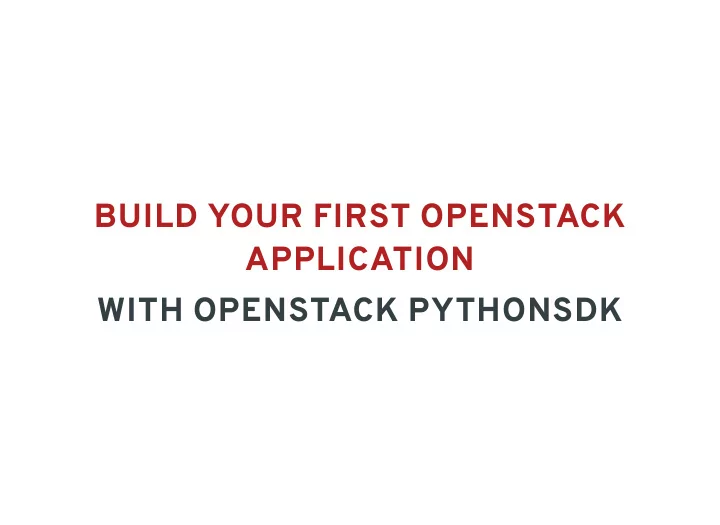

BUILD YOUR FIRST OPENSTACK APPLICATION WITH OPENSTACK PYTHONSDK
VICTORIA MARTINEZ DE LA CRUZ SOFTWARE ENGINEER AT RED HAT CO-FOUNDER LINUXCHIX ARGENTINA
WHAT IS OPENSTACK? BRIEF OVERVIEW
OPENSTACK OVERVIEW
IAAS... AND MORE! +
RUNNING APPS ON OPENSTACK HOW IT WAS... A FEW YEARS BACK
OSD GRACE HOPPER CELEBRATION 2014
OSD GRACE HOPPER CELEBRATION 2014 Leveraging OpenStack scalability and resiliency in times of need and disaster Defining a cloud-ready architecture for an standard application Deploying the application in no-time by just running an script
IN PREPARATION FOR OSD GHC 2014 Architecture the app to be cloud-ready → 2 webservers + 1 db + 1 load balancer Webserver DB LB Webserver
IN PREPARATION FOR OSD GHC 2014 Talk with an OpenStack cloud using python-*client
OPENSTACK PYTHON NOVA CLIENT # List servers in Nova from novaclient.v1_1 import client conn = client.Client(user, password, project, auth_url) from server in conn.servers.list(): print(server.name)
OPENSTACK PYTHON GLANCE CLIENT # List images in Glance from glanceclient.v2 import client conn = client.Client(auth_url, token) from image in conn.images.list(): print(image["name"])
OPENSTACK PYTHON SWIFT CLIENT # List containers in Swift from swiftclient import client conn = client.Client(auth_url, user, key, tenant_name, auth_version) header, containers = conn.getaccount() from container in containers: print(container["name"])
OPENSTACK LIBRARIES & SDKS COMMUNITY TOOLS FOR CLOUD DEVS
WHY? There is no way to just talk to an OpenStack cloud Lots of services. One lib per service, one ux per lib Lots of libs * lots of ux == sad cloud dev
APACHE LIBCLOUD Unified API Talking to different clouds (lots of plugins!) Third party
APACHE LIBCLOUD from libcloud.compute.types import Provider from libcloud.compute.providers import get_driver import libcloud.security libcloud.security.VERIFY_SSL_CERT = False OpenStack = get_driver(Provider.OPENSTACK) driver = OpenStack('your username', 'your password', ex_force_auth_url='https://nova-api.trystack.org:5443', ex_force_auth_version='2.0_password') nodes = driver.list_nodes() images = driver.list_images() sizes = driver.list_sizes() size = [s for s in sizes if s.ram == 512][0] image = [i for i in images if i.name == 'natty-server-cloudimg-amd64'][0] node = driver.create_node(name='test node', image=image, size=size)
OPENSTACK SHADE Simplicity OpenStack Infra subproject Under development, it is expected to change
OPENSTACK SHADE import shade # Initialize and turn on debug logging shade.simple_logging(debug=True) # Initialize cloud # Cloud configs are read with os-client-config cloud = shade.openstack_cloud(cloud='epcloud') # Upload an image to the cloud image = cloud.create_image( 'fedora24', filename='fedora24.qcow2', wait=True) # Find a flavor with at least 512M of RAM flavor = cloud.get_flavor_by_ram(512) # Boot a server, wait for it to boot, and then do whatever is needed # to get a public ip for it. cloud.create_server( 'my-server', image=image, flavor=flavor, wait=True, auto_ip=True)
OPENSTACK PYTHONSDK Complete set of libraries, tools, documentation and examples Aimed at all types of users Users of OpenStack clouds (probably YOU!) Operators of OpenStack clouds Developers of OpenStack projects Install once, run anywhere
OPENSTACK PYTHONSDK THE COMMUNITY PYTHONSDK FOR CLOUD DEVS
PYTHON OPENSTACKSDK Write Python automation scripts that create and manage resources in your OpenStack cloud $ pip install openstacksdk
PYTHON OPENSTACKSDK Connection Application developer consuming an OpenStack cloud Maintains your session, authentication, Connection transport, and profile Resource Resource OpenStack developer requiring finer-grained control
SOME SNIPPETS Establishing a connection with the cloud from openstack import connection # Connect def create_connection(): conn = connection.Connection(auth_url=AUTH_URL, project_name=TENANT_NAME, username=USER_NAME, password=USER_PASS) return conn
SOME SNIPPETS Creating a server from openstack import connection def create_server(conn): print("Create Server:") image = conn.compute.find_image(IMAGE_NAME) flavor = conn.compute.find_flavor(FLAVOR_NAME) network = conn.network.find_network(NETWORK_NAME) keypair = create_keypair(conn) server = conn.compute.create_server( name=SERVER_NAME, image_id=image.id, flavor_id=flavor.id, key_name=keypair.name, user_data=CLOUD_INIT) server = conn.compute.wait_for_server(server)
SOME SNIPPETS Creating a keypair import os from openstack import connection def create_keypair(conn): keypair = conn.compute.find_keypair(KEYPAIR_NAME) if not keypair: print("Create Key Pair:") keypair = conn.compute.create_keypair(name=KEYPAIR_NAME) try: os.mkdir(SSH_DIR) except OSError as e: if e.errno != errno.EEXIST: raise e with open(PRIVATE_KEYPAIR_FILE, 'w') as f: f.write("%s" % keypair.private_key) os.chmod(PRIVATE_KEYPAIR_FILE, 0o400) return keypair
MAKING YOUR APP CLOUD- READY SOME GROUND RULES
CLOUD READY & CLOUD CENTRIC Common classification Cloud ready: Effectively deployed into either a public or private cloud Cloud centric: Built using different tools and runtimes than traditional applications.
DYNAMIC APPLICATION TOPOLOGY If the topology can change, it will change Deploy your application to be as generic and stateless as possible. This will allow to: Selectively scale individual components Simplify maintenance and reuse Fault tolerance E.g. Don't hardcore information about networking, delegate it to the networking service
EPHEMERAL STORAGE Don't assume the local file system is permanent Use a remote storage for non-static data Cache Logs E.g. You can use the block storage service volumes to store data
STATELESS Statefulness of any sort limits the scalability of an application Remove or, if needed, store the session state in a HA store external to your app server (cache or database) E.g. You can use the databases service to spin up a DB instance
STANDARDS Use standards-based services and APIs for portability to cloud environments Avoid using obscure protocols Don't rely on OS-specific features
AUTOMATION Cloud apps need to be installed frequently and on-demand Automate configuration setup Minimize the dependencies required by the application installation
THX! vkmc@redhat.com vkmc at Twitter Q&A vkmc at irc.freenode.org OpenStack cloud native deployment for application developers D. Flanders Thursday, 2pm at Room E OpenStack Open Space Wednesday, TBD
USEFUL RESOURCES http://developer.openstack.org/firstapp-libcloud/ http://developer.openstack.org/sdks/python/ http://docs.openstack.org/user-guide/sdk_overview.html
Recommend
More recommend